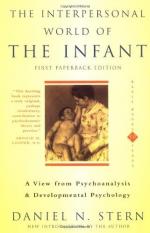
|
| Name: _________________________ | Period: ___________________ |
This test consists of 5 multiple choice questions, 5 short answer questions, and 10 short essay questions.
Multiple Choice Questions
1. Neurological and ethological viewpoints provide evidence that a sense of ______ is more sensitive during its formation.
(a) Knowledge.
(b) Self.
(c) Other.
(d) Memory.
2. The interpersonal ______ created by attunement is crucial for helping an infant realize that internal feeling states can be shared with others.
(a) Conversation.
(b) Communion.
(c) Aspecting.
(d) Education.
3. The attunements between a mother and a child can be cross-__________, or crossing many different sensory practices.
(a) Action.
(b) Piecing.
(c) Modal.
(d) Movement.
4. Stern believes that the capacities which tie diverse experiences of the social world together are largely determined by _________.
(a) Genetics.
(b) Myths.
(c) Environment.
(d) Books.
5. Stern notes that it is likely that __________ implications of this metaphor will come about slowly and indirectly.
(a) Clinical.
(b) Personal.
(c) Academic.
(d) Medical.
Short Answer Questions
1. __________ theory has also given intense emotional states an important organizing role, according to Stern's research.
2. Attunement is often seen as a stepping stone to __________, according to some researchers.
3. Sleep or ________ problems can also be what manifests after a person's core sense of self is dissolved for some reason.
4. What is NOT one of the three different qualities that can be matched in the process of affect attunement?
5. At this stage of development, infants become emotionally responsive to the perceptions of the _________ states of others.
Short Essay Questions
1. What does the quasi-imitation that happens between an infant and their mother produce?
2. What happens when a child reaches their second year of living, according to the book?
3. What sense is most sensitive during its formation, according to Stern in this book?
4. What might result in anxiety disorders later in life, according to Stern's studies in this book?
5. Why does Stern believe that the whole chain of reasoning that led to the idea of a barrier should be discarded?
6. What development has Stern's book sought to describe and to explore?
7. Why does Stern omit the idea of an oral stage when he discusses the infant growth stages, according to the content of the book?
8. What does it mean when the book says it is cross-modal and that it can cross sensory modalities?
9. What does Stern see as being the most important and clinically observable aspect of intersubjective relatedness?
10. Why does language cause a split in the experience of the self, according to the book?
|
This section contains 596 words (approx. 2 pages at 300 words per page) |

|




